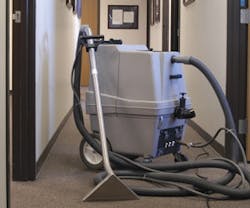Carpets normally perform an important service – they collect soils, allergens, bacteria, chemicals, and other contaminants tracked into the building and keep them from becoming airborne. But when the carpet is too soiled, the opposite occurs, negatively affecting IEQ.
“Carpet tends to trap and hide soil where it occurs,“ says Fritz Rench, CEO of dry extraction system manufacturer Racine Industries. “The soil-hiding capability fools facility managers and the custodial staff. They don't see it, but it’s building up.“
The more soiled your pathways are, the more unflattering and unhealthy your facility becomes. Stick to a four-step carpet maintenance program to make sure your floor always puts its best foot forward.
- Stay Current with Maintenance
It may seem simple, but regular vacuuming is the easiest way to minimize your need for costlier, more labor-intensive restoration. Daily vacuuming is ideal, even if the dirt isn’t yet visible to the naked eye, says Jeff Bishop, administrator of Clean Care Seminars.
“If you maintain and vacuum the carpet regularly, you’ll get the dry particle soils out,“ Bishop explains. “You need a preventive maintenance program. If you can avoid soil buildup, you’ll avoid permanent stains.“ - Conduct Interim Cleanings
Use minimal-moisture techniques to improve the carpet’s appearance between restorative cleanings.
Absorbent compounds and pads, dry foams, encapsulations, light shampooing, and soil transfer extraction improve the carpet’s aesthetic value when it’s not soiled enough to need restoration.
“These are techniques that don’t claim to remove large quantities of soil. They’re designed to improve aesthetics,“ Bishop says. - When Restoration Is Necessary
Though maintenance and interim cleanings can reduce how frequently your carpet requires restoration, soil will eventually build up to an extent that requires deep cleaning. Planning for an eventual restoration should be part of your regular maintenance program, Bishop says.
Restorative cleaning frequently involves extraction (hot water or dry) and may also incorporate some components of lighter cleaning, such as chemicals that break up or bind to carpet soils. This process not only improves the carpet's appearance, it also improves IEQ and makes the facility a healthier place to work.
“Mold spores are particularly troublesome as an asthma trigger,“ Rench says. “Dust could have any number of allergens in it.“
If the carpet is extremely dirty, you may still be able to salvage it, Bishop says. Try his four-part process to conquer heavy soiling:- Go over the area using an upright vacuum with brush agitation.
- Suspend the soil by first pre-spraying traffic areas using a preconditioner with a pH of 10 or less. Scrub the area with cylindrical brush agitation to ensure that the ground-in soil is suspended in the cleaning chemical, then let it sit for 20-30 minutes. “Suspension takes time,“ Bishop explains. “It’s a cleaning wand, not a magic wand.“ If necessary, repeat with dual-brush agitation.
- Rinse away suspended soil with multiple-pass hot water extraction, using an extractor other than a walk-behind or pull-back unit.
- Force-dry the carpet with air movers and put out safety signs until the carpet is dry.
- Don’t Forget Prevention
After the soiling is under control, consider adding preventive measures such as mats to heavily trafficked areas. A 3- by 10-foot entrance mat is a good choice for areas with frequent inclement weather, says Brad Heizman, national operations manager for Cintas Corporation’s facility services division.
Another entryway option involves a 4- by 6-foot scraper mat outside the entryway, along with a carpeted floor mat of the same length inside. This size ensures visitors will place both feet on each mat as they enter. Common areas and high-risk zones, such as water fountains, need only a 3- by 5-foot mat to prevent slips.
“You can’t look at the carpet without considering the other aspects of the building,“ Bishop says. “Are the grounds maintained properly? Are you conducting daily maintenance? Is the HVAC system maintained so that it filters soils out of the air instead of letting them filter onto the carpet? Look at the building holistically.“
Janelle Penny ([email protected]) is associate editor of BUILDINGS.
About the Author
Janelle Penny
Editor-in-Chief at BUILDINGS
Janelle Penny has been with BUILDINGS since 2010. She is a two-time FOLIO: Eddie award winner who aims to deliver practical, actionable content for building owners and facilities professionals.

